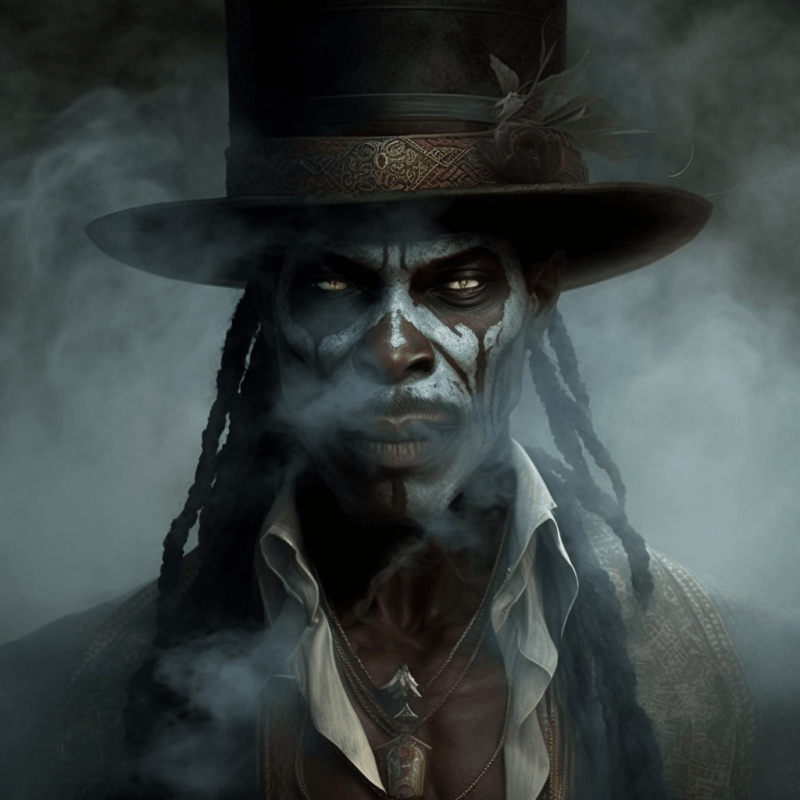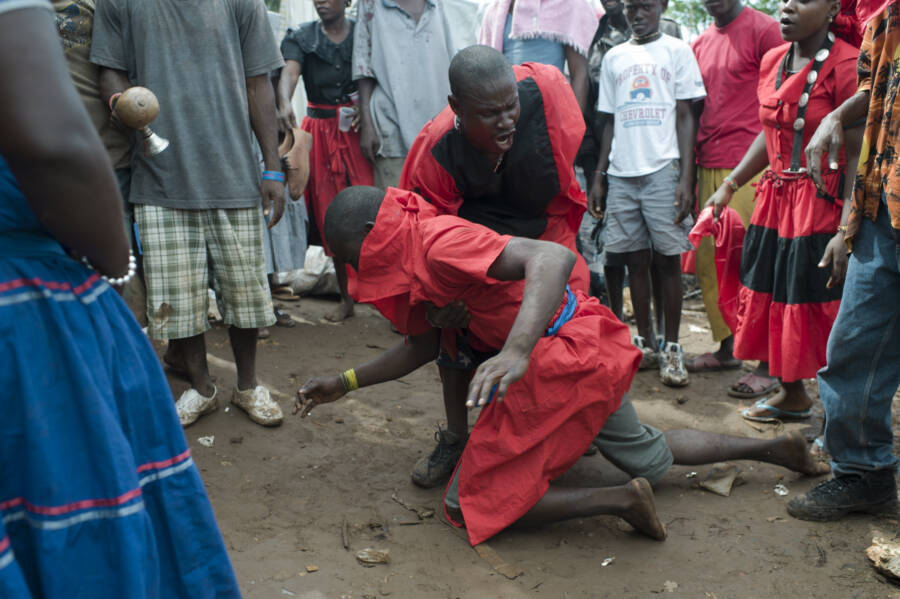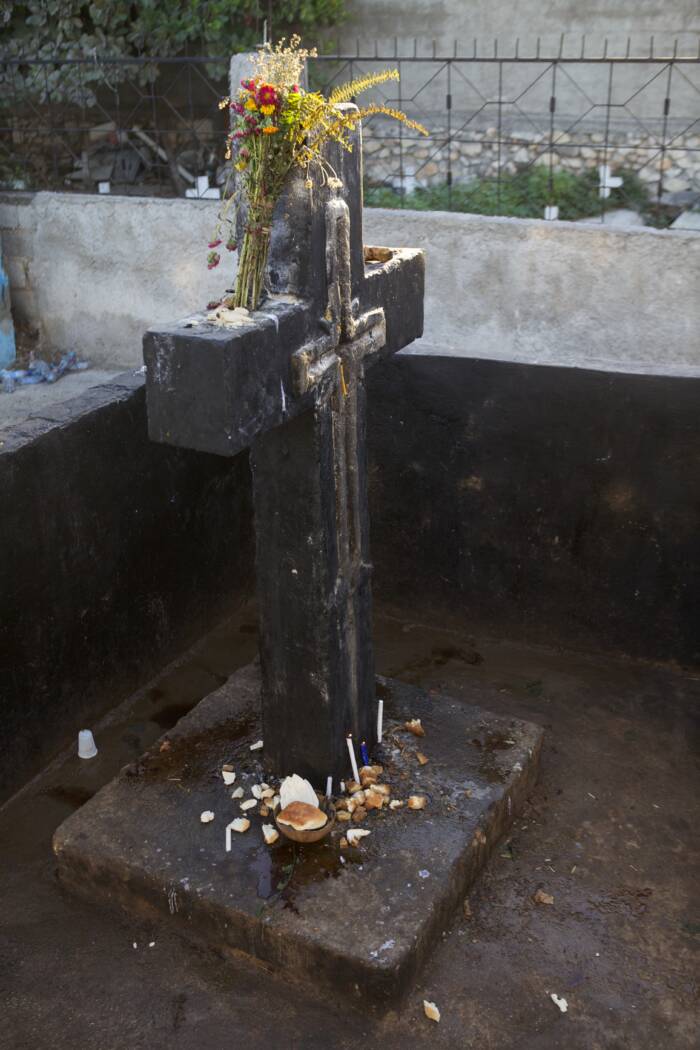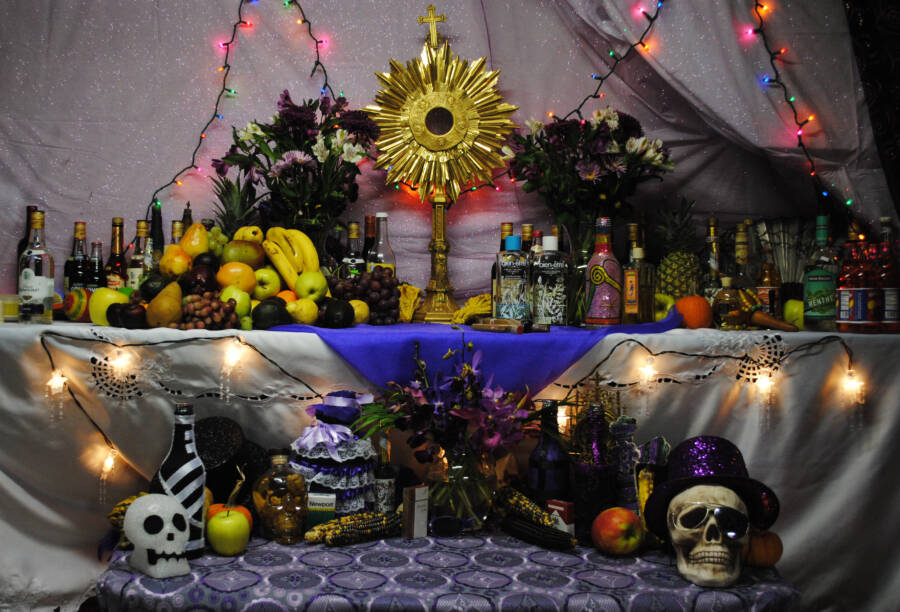Despite being the spirit that decides who lives and dies, Baron Samedi is depicted as an irreverent jokester who performs sexualized dances and is rarely seen without a cigar or a glass of spicy rum.

Wikimedia Commons
Baron Samedi, lwa of the dead.
He’s the poster spirit for the dark side of Haitian Voodoo. He’s the man waiting at the end of the tunnel, the one who decides who lives and who dies. He’s Baron Samedi, the Master of the Dead — and he’s here to take the dead to the afterlife.
In the Haitian Voodoo religion, the Baron is the spirit who bears souls to the underworld. But unlike figures such as the shinigami of Japan, the banshees of Celtic lore, or the Grim Reaper, Baron Samedi is not quite the menacing specter one might expect a personification of death to be.
A suave trickster known for his wicked wit, he takes joy in smoking, drinking, and obscenity. And as much as Baron Samedi is a bringer of death, he’s is also a protector of life, and he may be willing to spare yours — if you know how to bribe him.
Inside The Misunderstood Traditions Of Haitian Voodoo
While the Haitian Voodoo (Vodou) religion has a reputation for being associated with black magic and superstition, in reality, it functions as most religions do: It offers solace and comfort in an uncertain world.
As Smithsonian Magazine reports, Voodoo emerged as a result of European colonization in Africa and Haiti. Because of the influence of Catholic colonizers, it pulls from both Roman Catholicism and African religious traditions.
The religion materialized during a horrific period of slave trade at the island of Hispaniola. For many, it became a source of hope and strength in the face of oppression. Later, French colonizers saw Voodoo as a threat to the Catholic church, and they often persecuted practitioners brutally, as did some of the Black elites who led Haiti after the country gained independence.
Still, despite attempts to eradicate the supposedly “superstitious” practice over the centuries, Voodoo survived. It’s estimated that over half of Haitians observe it in some form today. And as a decentralized religion, it’s observed creatively in different forms all over the world.
Often referred to as “service to the spirits,” Voodoo involves practices like ancestor worship and trance possession by the spirits. But above all, Haitian Vodouisants believe there is one supreme, unknowable god. Since this god is unreachable, worshippers instead deal more directly with an array of subservient spirits called lwas — including Baron Samedi, spirit of death.

Anthony Karen/Wikimedia CommonsA photograph of a Houngan (Haitian Vodou priest) at a Vodou ceremony in 2021.
Who Is Baron Samedi?
Perhaps the most recognizable of the Haitian Voodoo lwa, Baron Samedi is the guardian of the underworld. You’ll meet him when death is near. According to Kreol Magazine, when a person dies, the Baron digs their grave. He then greets their soul as it rises from the grave, and guides them to the afterlife.
The Baron cuts a striking figure. In most depictions, he has a skull for a face and wears a long black tailcoat and top hat.
He dons dark glasses with the right lens removed so that he can keep one eye on the realm of the living. He is commonly depicted with cotton plugs in his nostrils as a corpse prepared for burial, and is rarely seen without a cigar in one hand and a glass of his signature spicy rum in the other.
The Baron likely shares this special rum with his wife, Maman Brigitte, the protector of gravestones and the dead. The rum is a home brew infused with 21 hot peppers, and is said to be too hot for any other lwa to handle.
Suave, mischievous, and known for his ravenous appetite, Baron Samedi indulges in life’s pleasures, chasing after women and his favorite foods while ridiculing anyone who takes life too seriously in his charmingly nasal voice.
Baron Samedi’s Role In The Voodoo Religion
Baron Samedi is the leader of the Gede family, the lwa that represent death and fertility. He is symbolized by coffins, skeletons, and black crosses.
As the chief spirit of the dead, the Baron guards the veil between life and death, welcoming new souls into the underworld and deciding who lives and who dies. In some cases, he may intervene to protect life. He’s said to have the power to break curses and heal mortals of any ailment if he finds them worth saving.
Those seeking to invoke his help may make an offering of strong black coffee, alcohol, or cigars. He’ll also look favorably upon a black rooster, goat, or grilled peanuts — his favorite foods. If you invoke his protection on behalf of a child, the odds are slightly in your favor. Baron Samedi is fond of children, and prefers that they get to experience a life fully lived before being escorted into the afterlife.
If you need to communicate with deceased family members, you can call on the Baron to assist you in speaking with them. He also ensures that corpses rot properly so they don’t become zombies and wreak havoc on the living. Of course, he expects payment for this service. (The usual offering of cigars, alcohol, or grilled peanuts will suffice.)

Jean-noël Lafargue/Wikimedia CommonsThe term “zombie” (zombi) comes from Haitian folklore, in which it is defined as a dead body is reanimated through magical practices.
Different Depictions Of The Baron In Voodoo Lore
There are three incarnations of Baron Samedi, sometimes portrayed as separate spirits. The first is Baron La Croix. He is debonair, suave, and sophisticated. With an existential philosophy about death, he finds it absurd to the point of hilarity and reminds us to enjoy life’s pleasures.
Second is Baron Cimetière, the guardian of cemeteries. His taste is expensive. He drinks wine and fine liquor, and dresses his horses in tuxedos and top hats. Though on the surface he’s more polite than the other incarnations, he’s still lewd, but simply puts on an upper-class air.
Finally, there’s Baron Criminel, who is believed to be the first murderer ever condemned to death. Worshippers invoke him for rightful revenge and swift judgement. The most fearsome and sadistic of the incarnations, he also has the power to possess mortal souls. Those possessed by Baron Criminel may shout profanities, spit, and attempt to stab anyone nearby.

Andrew Welch/Wikimedia CommonsBaron Samedi’s cross at a cemetery in Port-au-Prince, Haiti.
How Baron Samedi Is Honored Today
Over the years, Baron Samedi has had a massive impact on pop culture, inspiring characters in television shows like American Gods, American Horror Story: Coven (as Papa Legba), and Supernatural. There’s even a nod to Baron Samedi in the Disney film The Princess and the Frog, in which the villain Dr. Facilier dresses in a manner very similar to the lwa.

wbur/FlickrA Manje Lwa altar with food and decorations.
Every November 1 and 2, Vodouisants celebrate Fèt Gede, the Haitian Voodoo Day of the Dead, a festive celebration to honor loved ones who have died as well as Baron Samedi and the other Gede. Far from being a mournful occasion, this celebration usually consists of a parade, boisterous graveyard parties, colorful costumes, lots of drinking, and erotic dancing.
These exuberant ceremonies parallel the way the Gede lwa approach death. As Catherine Beyer notes in her article “An Introduction to the Basic Beliefs of the Vodou Religion,” the Baron and other Gede lwa “transport dead souls, behave irreverently, make obscene jokes, and perform dances that mimic sexual intercourse. They celebrate life in the midst of death.”
In this way, Baron Samedi offers a comforting message that death isn’t necessarily something to be afraid of — as well as a reminder to make the most of the time we have on Earth before it’s our time to meet the Baron.
After reading about Baron Samedi, read about the true story of Marie Laveau, the infamous Voodoo priestess of New Orleans. Then, learn about how a group of people gathered in 1941 to try to kill Hitler with Voodoo magic.





